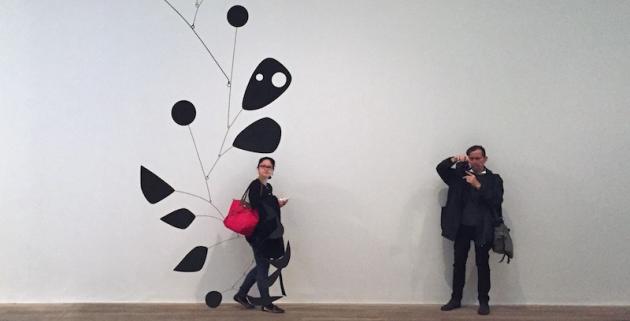The UK’s largest ever exhibition of Alexander Calder (1898-1976) is currently on at London’s Tate Modern. Calder is considered one of the most innovative artists of the 20th century and a pioneer of kinetic sculpture. He played an essential role in shaping the history of modernism. Alexander Calder: Performing Sculpture brings together approximately 100 works to reveal how Calder turned sculpture from a static object into a continually changing work to be experienced in real time.
 Image: Alexander Calder, Performing Sculpture, Tate Modern, Installation View, 2015. Photo: P C Robinson © Artlyst 2015
Image: Alexander Calder, Performing Sculpture, Tate Modern, Installation View, 2015. Photo: P C Robinson © Artlyst 2015
Calder initially trained as an engineer before attending painting courses at the Arts Students League in New York. He travelled to Paris in the 1920s where he developed his wire sculptures and by 1931 had invented the mobile, a term first coined by Marcel Duchamp to describe Calder’s motorised objects. The exhibition traces the evolution of his distinct vocabulary – from his initial years captivating the artistic bohemia of inter-war Paris, to his later life spent between the towns of Roxbury in Connecticut and Saché in France.
 Image: Alexander Calder, Performing Sculpture, Tate Modern, Installation View, 2015. Photo: P C Robinson © Artlyst 2015
Image: Alexander Calder, Performing Sculpture, Tate Modern, Installation View, 2015. Photo: P C Robinson © Artlyst 2015
The exhibition also features some of his figurative wire portraits Calder created of other artists including Joan Miró 1930 and Fernand Léger c.1930, alongside depictions of characters related to the circus, the cabaret and other mass spectacles of popular entertainment, including Two Acrobats1929, The Brass Family 1929 and Aztec Josephine Baker c.1929. Following a visit to the studio of Piet Mondrian in 1930, where he was impressed with the environment-as-installation, Calder created abstract, three-dimensional, kinetic forms and suspended vividly coloured shapes in front of panels or within frames hung on the wall. Red Panel 1936, White Panel 1936 and Snake and the Cross 1936 exemplify the artist’s continuous experimentation with forms in space and the potential for movement to inspire new sculptural possibilities. They are shown together with a selection of other panels and open frames for the first time, illustrating this important moment in Calder’s development.
Read Artlyst’s review here
Words: Ann Coxon Curator International Displays, Tate Modern, Achim Borchardt-Hume Director Exhibitions, Tate Modern, Alexander S C Rower Chairman Calder Foundation.
Photos: P C Robinson © Artlyst 2015
Alexander Calder: Performing Sculpture – Tate Modern – until 3 April 2016

